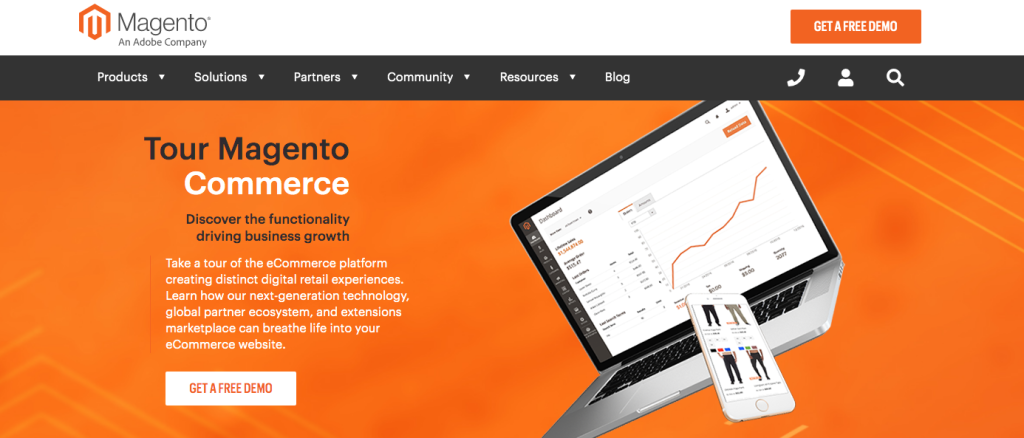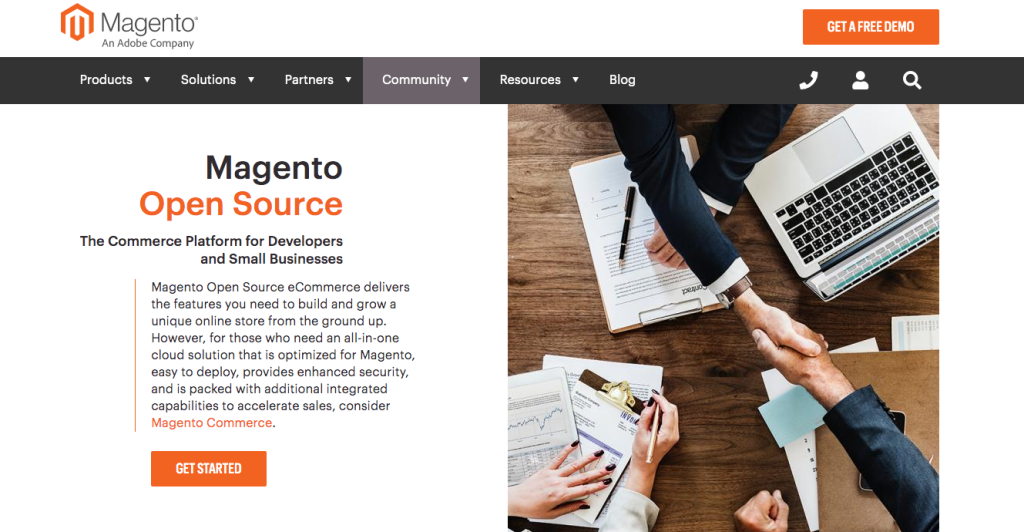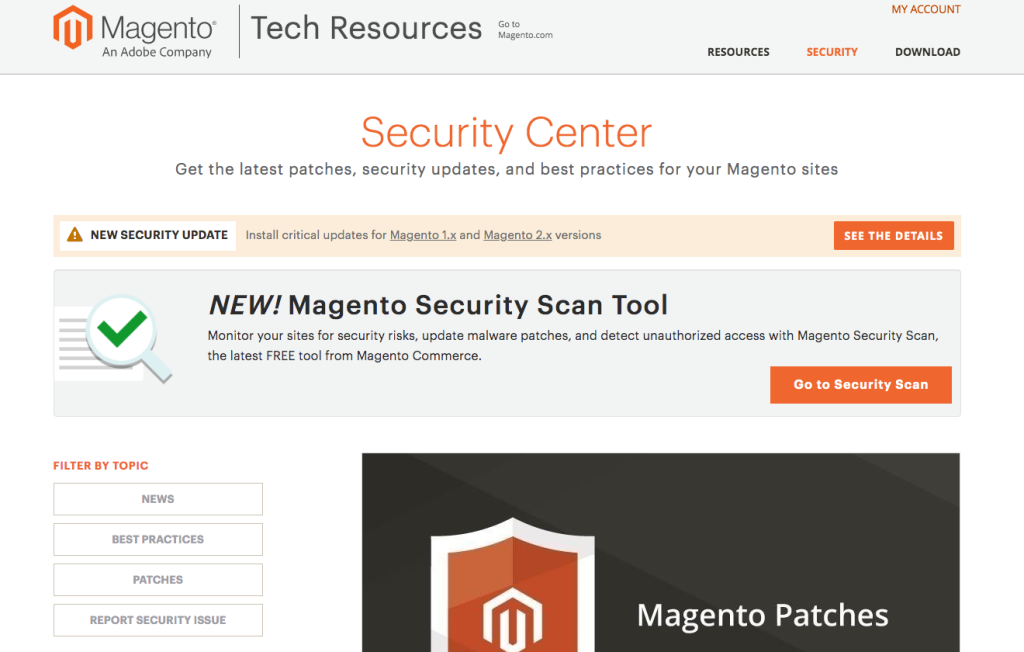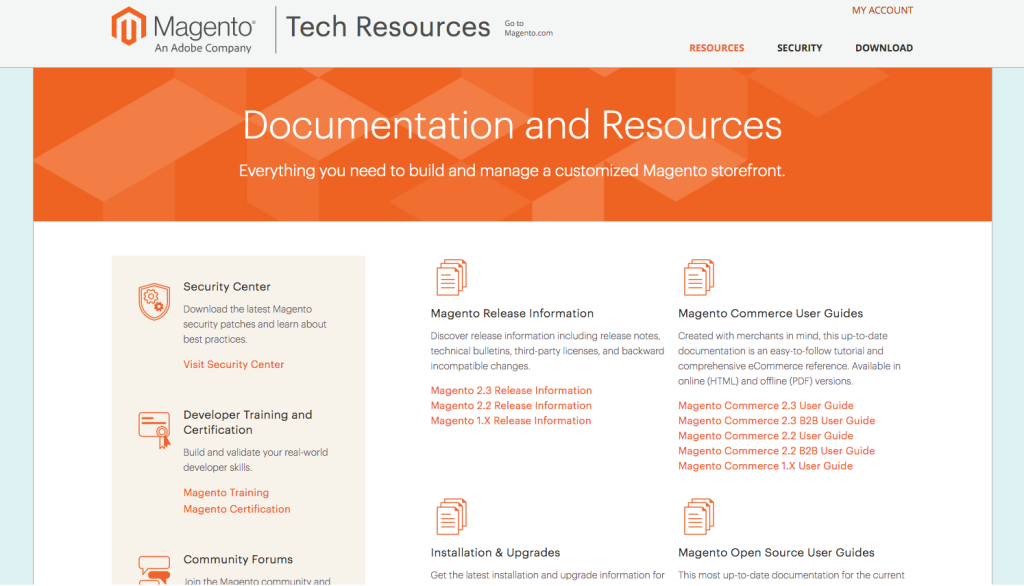If you are a business person, and you’ve been using various online platforms, then you must have heard of platforms such as Shopify, BigCommerce, and, Volusion, among others. However, do you know which is another popular platform among them? You guessed that right, Magento it is.
This platform boasts of over 250,000 merchants using it, and the numbers are continuing to grow. Well, this store building platform owes its popularity to the expansive feature set that it comes with, and also the ability to allow users to customize their stores according to their desires.
Roy Rubin and Yoav Kutner are the brains behind this fantastic platform. It was found in 2007 and sold in 2011 to eBay. In 2015, the platform changed hands again as eBay sold it to a group of investors. As we speak, Magento is currently being owned by Adobe since acquiring it back in 2018.
This review will highlight a few things you need to know Magento, including some of its best features.
Which of Magento eCommerce Packages Is Best Suited For Business?
Is Magento any good? Well, let’s find out. Generally, the Magento platform comes in two variations. Magento Commerce and Magento Open Source. They both serve for businesses. However, each of them will suit a particular business’ type and size. Let’s start by having a look at Magento Commerce.
Magento Commerce Overview

This is what was before known as Magento Enterprise Edition. It is a licensed version of Magento commerce services. However, it offers a lot more than just being a licensed version of Magento Open Source. This Magento pricing starts at $24,000 a year.
This edition was initially intended to be used by large-scale organizations that need a higher level of support and a broader set of functionalities. It comes completely packed with a set of great configurable features to improve the overall user experience.
A few additional benefits that come with Magento Commerce includes; offering technical support and dedicated account management. It has a few unique features as well, such as Magento Order Management, Magento Shipping, and ElasticSearch, among others.
This is why you will have to incur the Magento enterprise cost. The edition is also divided into two different versions: Magento Commerce Pro and Magento Commerce Starter. Magento Commerce Pro is a right solution for retailers looking for an Enterprise Cloud hosting services combined with the Magento Commerce license. The pricing of this version starts at $3,399 per month.
The Starter edition, on the other hand, comes with a pricing of $1,999 per month. It can be used by those looking to combine their Magento Commerce license with a Cloud Hosted infrastructure at an affordable price.
There are also a few differences between the two. For instance, the Pro edition comes with business intelligence features that can give you full access to your data while the Starter edition doesn’t have these features. They can, however, be added but at some additional cost. Let’s move on to another Magento 2 package review.
Magento Open Source Overview

This Magento costs nothing. It is entirely free to download and get built-in basic functionality. This Magento open source edition was introduced back in 2008 and was known as Magento Community. As the name suggests, this Magento version is free of charge and therefore available for everyone to use.
It also allows users to install and use some extensions and make some adjustments during the configuration of the software. This offers a chance to the users to customize it and use it according to their desires. The Open Source edition makes a good solution to startups or growing businesses due to its ease of use.
It allows users to build eCommerce stores quickly and comes with a variety of great tools to improve user experience. However, Magento has always been working with a very talented team of developers to bring new extensions, adding to what it already has.
This makes it even much easier to use the software as it adds more functionality to it. More about this can also be found in an exclusive Magento community review.
Features of Magento eCommerce Platform
To understand more about the software, let us see some built-in features it comes with and why they make great Magento solutions.

1. Inventory Management
Among the things that make Magento so easy to use is its ability to let you control your online shop. Through the dashboard, you can access your inventory as well as your orders.
Furthermore, you can add products and put them into different groups, categories, or bundles. It also allows you to keep track of your inventory, create nice templates for your product, and various business models such as digital goods, services, and subscriptions.
2. Coupon Management
Magento platform makes it easy for its users to entice their customers by allowing them to offer great deals to the customers. Some of these great deals usually involve purchasing items at a discounted price.
Aside from discounts, users can also use the coupon management feature to create coupon codes that people can use in your shop. This will allow you to apply discounts on a few selected items in the store. This helps in capturing your visitor’s attention and most influence their decision to buy something.
Log in to the backend of your shop and configure your default coupon settings. You can also access the Cart Price Rules if you want to edit your existing coupon codes or when creating a new one.
3. Multiple Payment Gateway Options
To make your business even more efficient, you can integrate multiple payment methods with your online shop. This can be done in your admin settings simply by putting them on or off.
This is a great feature as it also allows different customers to choose their desired methods of payment. The various payment methods include Authorize.net, PayPal, WorldPay, and CyberSource, among others.
Useful for you:
4. API for Web Services
Magento has a web API feature that allows the users, through developers, to create and use web services that can interact with the Magento software.
These web APIs are often used to perform various functions including; ERP, CRM, and CMS integration, creating a shopping app, and also creating Javascript widgets to use in your storefront or your admin dashboard.
5. Customer Groups
This is also another great feature offered to help its users to manage their targeted customers. This feature helps when it comes to marketing your products.
It allows the users to control their visitor’s user experience for different customers. You can also categorize your site’s customer base into different groups.
You can then start creating rules, taxing classes, and grouping specific discounts depending on the individual customer group.
6. Product Bundles
When you make it fast and easy for your shoppers to find the items they need, your sales can greatly improve. This is why Magento offers its users the ability to create groups of items that are related.
This is achieved through product bundling. It can simplify your customers’ choice, thereby positively influencing the shopper’s decision to buy a product.
This feature enables you to create custom bundles and let the visitors create individual bundles of their own from the options you had already bundled up. Apart from boosting your sales, it also improves the customer experience.
7. Built-in SEO Features
When doing business online, you know the importance of staying at the top of the search engine. This plays a very key role in terms of sales conversion. This has been a challenge to most online stores but not when you are using Magento. The platform comes with built-in SEO features to help you get started with the basic requirements of on-page SEO. You can configure your SEO settings also at the admin panel.
8. Marketing Tools
Marketing is always a key factor to consider for a business organization to become successful. Depending on the marketing strategies you use, proper marketing can bring a huge difference when it comes to sales.
Magento has a few selections for their users to strengthen their marketing sector. These tools focus much on two areas. The first one is to help you expand your brand awareness and reach. This enables users to make more sales conversions by creating more opportunities.
The second focus is on helping you to get your customers to spend more. This will increase your average transaction value. With all the marketing tools provided, you can increase your profits and steer your business right to success.
9. Site Management Features
The site management features are those that Magento has enabled you to control multiple stores and sites from your admin panel. They also allow you to customize templates to achieve your desired designs.
They also support multiple currencies and languages for smooth transactions. When using the Magento platform, you don’t have to worry about robots trying to access your site. You can keep your site safe using the CAPTCHA functionality.
These features also make it easy for users to import and export catalog and other customer information.
10. Newsletter Management
This allows you to create and manage mailing lists within the platform. With these features, you can allow your visitors to subscribe to your newsletter from the account, product or checkout pages.
The newsletter management features make it easy for you to categorize your customers and manage their information based on their order statuses.
The features also help your marketing efforts as they allow you to run targeted advertisements or promotions according to your subscriber groups. In general, these features are meant to improve your business through email marketing.
11. Order Processing
If you want to run a successful business, then you must prepare yourself to handle a lot of sales orders. However, since most order management systems are often not that much powerful, Magento lets you use its amazing order processing features. This makes your order fulfillment easy and fast.
The process involves three main stages. You will first need to log into the backend of your shop and see if you have any pending orders.
If you do, the second phase involves carefully examining the following sections; address information, order and account information, ordered items, and the preferred payment and shipping method.
When all of this is done, you can proceed to complete the order total section, and that’s it.
Useful for you:
Magento Themes and Designs
Magento gives you a platform to build your store and allows you to use its templates. When you use free themes, you will notice that they are quite basic or have minimal functionalities in their designs. However, to set up plain Magento 2 store, you can use the Luma theme which is offered by Magento. It is great for a start, and gets you covered with basic functionality for the store.
But this shouldn’t be why you can’t have a beautiful store with amazing functionalities. You can always reach out to the paid versions of the Magento themes and designs as they are quite flexible and come with many functionalities. You can check Magento Marketplace or any other website like Themeforest that offers themes and templates, and choose the one you like by style and features.
These themes can also be customized according to the user’s desires to improve the visual options and the general layout of the design.
Magento Services and Support
Magento Security Services

Besides excellent documentation guidelines, Magento offers a free security scan tool to detect any glitches and update patches at your store. Also, they provide security services that cost form $1,000 to $5,000 and solve SQL injection vulnerabilities. When you just launched your store, Magento gives you PCI compliance and two-step authentication plus Google reCAPTCHA to protect your business and visitors from any system and data attacks.
Magento Knowledge Base

For their customers, Magento has prepared an extensive documentation base along with useful guides on their products, and latest eCommerce trends. If you want to check the current version tech stack and features, or to learn how to increase the efficiency of your store, you can refer to the tech or library resources.
Among other useful resources that you can find on the Magento site are the following:
- User Guide
- Magento Community Forums
- Blog on eCommerce and Magento Usage topics
- User Guide for Magento Marketplace
- Resource Library: Webinars, tutorial videos, topical guides.
- Support: For sales and general info, but not specific tech support questions.
- Training courses & certification at Magento U.
Pros and Cons of Magento eCommerce Platform
Pros of Magento
Below are some few advantages you can enjoy when using the Magento eCommerce software.
User-Friendly. As mentioned before, this is an amazing feature-rich eCommerce software and a quite popular one for that matter. These features are great for better performance.
Scalable. Well, for those merchants looking fort a scalable eCommerce software, try Magento. Clearly, the reason why most top businesses use it and currently hosts over 125,000 sites.
Feature-Intensive. Magento has a lot of amazing features that make work much easier when it comes to store management, among other things.
Cons of Magento
The software also has a few shortcomings. Below are some of them.
Costly. It becomes a bit expensive to access various features with tons of functionalities. For your shop to keep on working efficiently, you need to invest. This means parting with some extra bucks. Maintaining such a great platform also comes at a cost.
Time-Intensive. Generally, Magento is an amazing business software to use when getting into the eCommerce business. However, it can be quite challenging and time-consuming, especially when moving from one version to another.
Magento is a force to be reckoned with when it comes to eCommerce platforms. It comes with great features and tools to help you build a store, add products, manage it, and make profits. This is an awesome software to use if you want to own an online store.